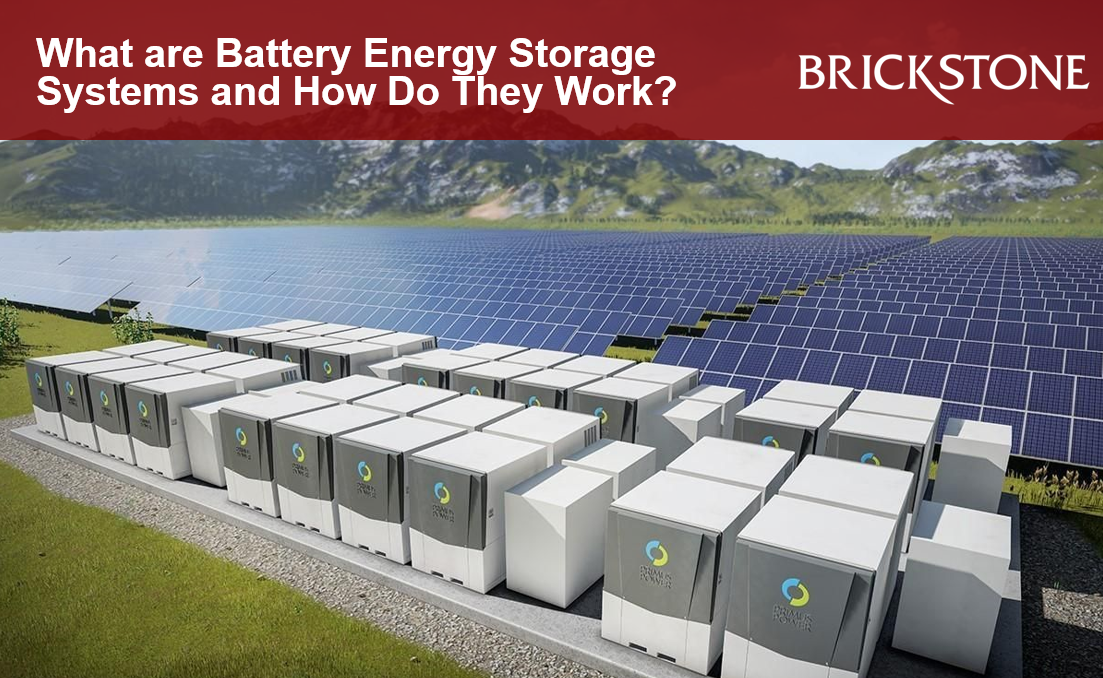What Are Battery Energy Storage Systems and How Do They Work?
As the need for power system flexibility and sustainability has grown alongside the rapid decline in the cost of storage technologies, especially lithium-ion batteries, the interest in grid-scale battery energy storage systems has over time gained much prominence. In this regard, recent estimates show that the global market for battery energy storage systems will grow at a compound annual growth rate of 32.8 percent from 2020 to 2025, rising from $2.9 billion in 2020 to $12.1 billion in 2025.
This article by Brickstone reviews some institutional reports and publications on Battery Energy Storage Systems, explaining what they mean and how they work.
What Are Battery Energy Storage Systems?
Battery energy storage systems (BESS), also called rechargeable battery systems, are an advanced technological solution that allows the storage of energy in multiple ways for later use. BESS consists of one or more batteries and can be used to balance the electric grid, provide backup power and improve grid stability. This stored energy can then be drawn upon when needed to meet various demands for power across different applications.
Battery energy storage is critical to decarbonizing the power system and reducing greenhouse gas emissions. It’s also essential to build resilient, reliable, and affordable electricity grids that can handle the variable nature of renewable energy sources like wind and solar.
From renewable energy producers, conventional thermal power plant operators and grid operators to industrial electricity consumers, and offshore drilling platforms or vessels, BESS offer highly efficient and cost-effective energy storage solutions. According to SIEMENS, with BESS, you can even generate new revenue streams as it allows energy arbitrage or directly reduces your electricity bill via peak shaving.
In summary, the following are key advantages of Battery Energy Storage Systems:
- Provide a cost-effective way to store excess energy generated by renewable sources like wind and solar farms.
- Can store excess electricity generated by renewable energy sources such as solar or wind farms, allowing it to be used at a later time when these sources are not available.
- BESS can provide backup power during outages or extreme weather events, reducing the need for costly distribution upgrades or emergency generators.
- Assist in load leveling and grid support, helping to balance fluctuations in electricity demand throughout the day and reduce congestion on the grid.
- Bess can improve power quality by smoothing out voltage fluctuations that may otherwise disrupt equipment operations.
- Many types of BESS are easy to install, making them a popular choice for businesses and homeowners looking for reliable energy storage systems.
Battery Energy Storage Systems also comprises a compound system that includes hardware components along with low-level and high-level software. The main BESS parts include:
- A battery system. It contains individual battery cells that convert chemical energy into electrical energy. The cells are arranged in modules that, in their turn, form battery packs.
- A battery management system (BMS). A BMS ensures the safety of the battery system. It monitors the condition of battery cells, measures their parameters and states, such as state-of-charge (SOC) and state-of-health (SOH), and protects batteries from fires and other hazards.
- An inverter or a power conversion system (PCS). This converts direct current (DC) produced by batteries into alternating current (AC) supplied to facilities. Battery energy storage systems have bi-directional inverters that allow for both charging and discharging.
- An energy management system (EMS). This is responsible for monitoring and control of the energy flow within a battery storage system. An EMS coordinates the work of a BMS, a PCS, and other components of a BESS. By collecting and analyzing energy data, an EMS can efficiently manage the power resources of the system.
How Does Battery Energy Storage Systems Work?
BESS relies on one or more batteries to store energy, which can then be used at a later time. These batteries may be charged using excess electricity generated by wind or solar farms, for example, or by grid connection during periods of low demand. Then the intelligent battery software uses algorithms to coordinate solar production, usage history, utility rate structures, and weather patterns to optimize when the stored energy is used.
Once the battery is full, it stores the electricity until it is needed.
Read more on Battery Energy Storage Systems here.





